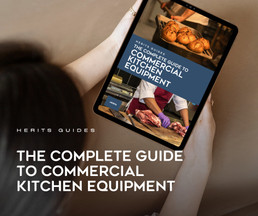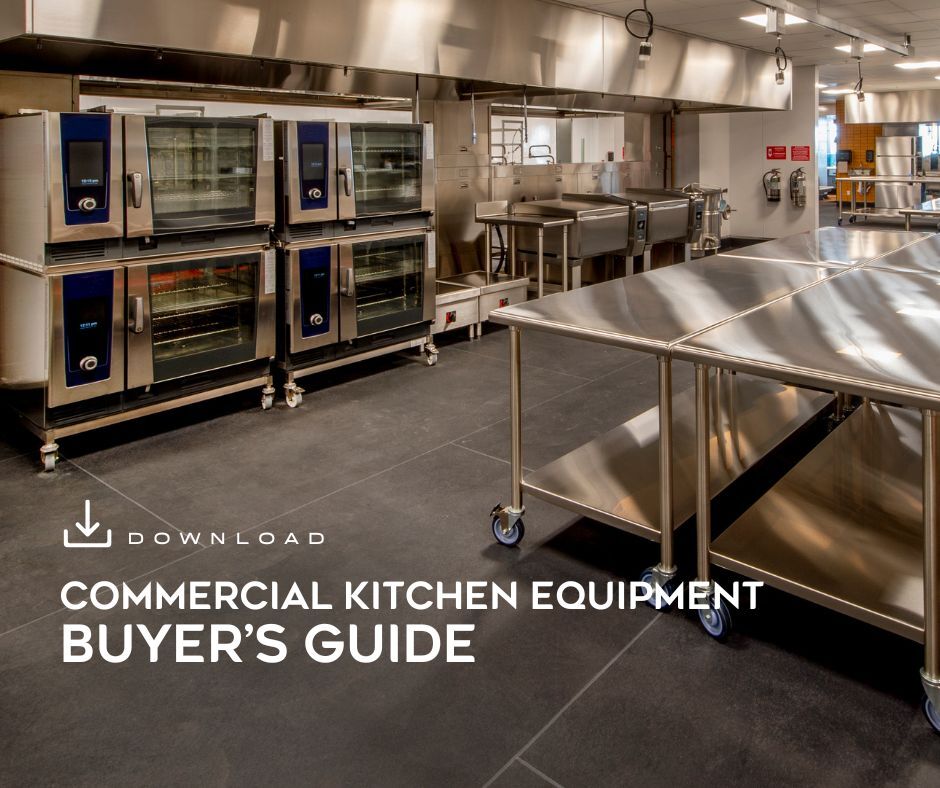28th Oct 2025
The Complete Guide to Commercial Kitchen Equipment
Setting a new standard in trust, service and performance.
Every professional kitchen is a living system built on rhythm, precision and resilience. The right equipment defines that rhythm, giving teams confidence to deliver exceptional service every day. The wrong choice, can disrupt performance, waste resources and create unnecessary risk. When you run a restaurant, a bakery, or a food manufacturing business, the equipment you select will determine how efficiently and safely you work.
Herits has spent years in the industry, supporting businesses of every size with reliable, data-led advice and equipment that performs under pressure.
This guide brings together our collective experience, helping decision-makers plan, purchase and maintain equipment that performs in real-world conditions. It’s designed for professionals who understand that every piece of kit in their kitchen contributes to speed, consistency, safety and profit.
Expect practical frameworks, insider knowledge, and Herits-exclusive tools to help you build commercial kitchens that last.
What Defines Commercial Grade Equipment
Commercial kitchen equipment is engineered for intensive daily use in demanding environments. It’s built to endure heat, cleaning, vibration and constant handling. Unlike domestic appliances, which are designed for occasional use, commercial equipment delivers consistent output hour after hour without degradation. Materials like stainless steel, high-temperature plastics and corrosion-resistant coatings are selected for resilience. Temperature precision, power efficiency and cycle stability are the core differentiators.
Modern catering environments also expect smarter, safer and more sustainable solutions. Features such as programmable controls, digital monitoring and improved energy management have become essential. These tools help operators reduce waste and ensure consistent food quality.
Refurbished versus new
Refurbished catering equipment is now a cornerstone of professional kitchens. Each Herits refurbished machine undergoes full inspection, reconditioning and certification to match or exceed manufacturer standards. Refurbished units deliver high performance with reduced carbon impact and lower capital cost. With clear service histories, warranties and compliance certificates, our equipment offers transparency, safety and long-term assurance.
Planning a Kitchen for Efficiency
A kitchen’s performance is only as good as its flow. Planning your layout for efficiency reduces wasted movement, saves energy and helps your team work in sync. Start by analysing your menu and identifying key process points, from receiving ingredients to plating. Trace the path of food, staff and equipment through your kitchen during peak service times. Look for bottlenecks, unsafe overlaps and dead zones.
Divide the kitchen into clear functional zones: goods-in, storage, prep, cook, pass and wash. Each area should have logical adjacency to the next, reducing double handling. Equipment positioning matters. Keep refrigeration near prep benches, keep cooking equipment aligned under extraction, and ensure dirty-to-clean dish flow avoids cross-contamination.
Lighting, ventilation and ergonomics shape how long staff can sustain their pace. Even minor layout adjustments can reduce strain and improve communication. Treat the kitchen as a performance space where efficiency, safety and comfort all drive productivity.
Total Cost of Ownership Explained
The Total Cost of Ownership (TCO) model provides the clearest financial picture of any equipment investment. It considers every factor that influences long-term value, from installation and training to utility costs, maintenance and lifespan. A machine with a higher upfront price might deliver better returns if it runs more efficiently and lasts longer.
The Herits TCO Calculator simplifies this process. Add your purchase and installation costs, estimate monthly energy use, include projected maintenance, and divide by the expected months of service. The resulting figure gives you a monthly cost of ownership. Comparing TCO between options reveals which delivers the most value, not just the lowest sticker price.
Comparing total cost of ownership (TCO) between options reveals which delivers the greatest value, not simply the lowest upfront price.
For instance, a £3,000 refurbished oven with a £300 installation fee and a £40 monthly running cost over five years equates to about £130 per month in ownership costs. Add another £40 for energy, and you have a realistic monthly figure for forecasting.
Energy, Compliance and Sustainability
Energy performance and compliance are now as important as output. Businesses that invest in efficient equipment save money, reduce emissions and demonstrate responsible management. Efficient burners, smart refrigeration systems and insulated ovens can cut power use by as much as thirty percent compared to legacy units. These savings compound quickly over years of operation.
Herits helps operators identify energy hotspots and replace inefficient assets strategically. Refurbished systems extend sustainability benefits further by reducing embodied carbon. Each reused unit prevents hundreds of kilograms of CO₂ emissions. This contributes to local environmental targets and national decarbonisation goals.
Every Herits installation follows UK compliance standards. Gas work is handled by certified Gas Safe engineers, electrical systems undergo periodic testing, and all ventilation systems meet airflow and grease capture regulations. Consistent documentation and proactive audits protect your operation and reputation.
Prioritising replacements for smarter investment
Every kitchen has equipment that works hard and equipment that holds the team back. Taking time to assess performance, efficiency, and compliance helps business owners decide what to replace or refurbish first. When decisions are based on evidence rather than urgency, capital budgets go further and downtime is reduced. Evaluating each machine by cost, reliability, energy use, and suitability gives a clear picture of where upgrades will have the biggest impact. This approach turns equipment management into a planned investment strategy, not a reaction to failure, and that’s where long-term savings begin.
Kitchen Equipment Categories
Cooking Equipment
Your cooking line defines your kitchen’s tempo. Choose appliances that match peak service load rather than average use. Consider heat recovery, airflow and extraction early in planning. Durable materials like 304-grade stainless steel improve clean-down efficiency and reduce contamination risk. Balanced cooklines minimise operator fatigue, prevent heat build-up and streamline plating.
Refrigeration
Essential for food safety. Choose refrigeration with correct ambient temperature ratings and energy-efficient compressors. Keep units clear of obstructions to maintain airflow. Consider remote condensers to remove excess heat and noise from work zones. For multi-site operators, smart refrigeration offers remote temperature logging for audit-ready compliance.
Food Preparation
Preparation equipment saves labour and ensures precision. Select the right bowl sizes, blade assemblies and attachments for your daily batch volume. Prioritise designs that are easy to clean, because simple maintenance drives consistency. Ergonomic tabling and safe clearances around moving parts help staff work faster and safer.
Warewashing
High throughput washing systems are vital for hygiene. Plan for dirty-in and clean-out separation, adequate water supply and chemical dosing. Position tabling to maintain flow and reduce recontamination risk. Daily filter cleaning and descaling extend lifespan and maintain speed.
Packaging and Sealing
If your business serves retail or delivery markets, packaging quality matters. Match vacuum levels, seal integrity and hygiene zoning to your product shelf-life targets. Small packaging faults can affect compliance and presentation, so invest in correct training and maintenance.
Future-Proofing and Innovation
Tomorrow’s commercial kitchens will rely on technology, automation and data insight. IoT-enabled machines now alert managers before breakdowns occur, reducing downtime. Predictive maintenance systems monitor load cycles, power draw and fault history. Energy-monitoring dashboards show which assets are underperforming or consuming more than expected.
AI-assisted cooking and programmable combi systems are improving consistency and reducing training time. Modular kitchen builds and hybrid energy designs allow operators to adapt quickly as menus and staff evolve. These advances are already accessible to SMEs and deliver immediate returns in reliability and staff retention.
Safety, Maintenance and Best Practice
Safety isn’t optional; it’s a culture. The best kitchens weave compliance, training and inspection into daily operations. Create clear cleaning schedules, log equipment checks, and make isolation points visible. Small details prevent big accidents. Gas interlocks, safe shutdown procedures and regular PAT testing keep risks minimal.
Maintenance protects your investment. Routine filter cleaning, gasket inspection and calibration sustain performance and preserve warranties. Build proactive maintenance into shift structures rather than treating it as an afterthought. Partner with suppliers who respond quickly, hold stock, and offer technical support to keep your operation steady.
Tools and Resources
Herits gives decision-makers the clarity and confidence to invest wisely. Our suite of free resources supports better purchasing, faster planning and safer compliance:
|
Tool |
What it Does |
|
Calculates lifetime ownership cost |
|
|
Assess ten critical buying factors |
|
|
Your guide to choosing kitchen and catering equipment |
Explore these resources and experience the Herits difference. For kitchens that perform better, last longer and run smarter.
Herits: setting a new standard for trust, service and performance in commercial kitchen equipment.



